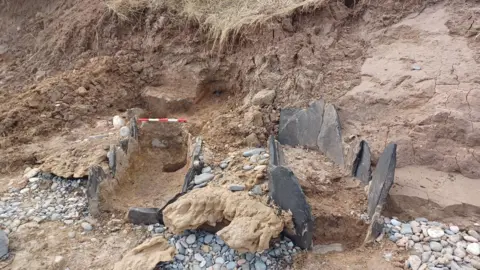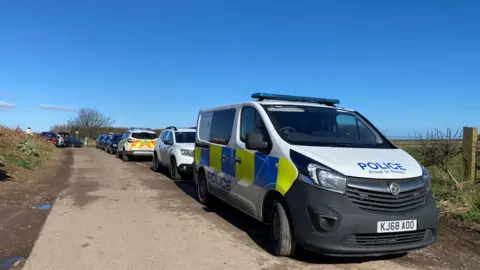Structures in cliff are centuries-old 'fishing tanks'
 Sarah Winlow, Northumberland Coast National Landscape
Sarah Winlow, Northumberland Coast National LandscapeStructures which emerged from a cliff due to coastal erosion may be connected to a centuries-old fishery in the area, experts believe.
Police were called to Foxton beach in Northumberland in March when the rectangular boxes were spotted by a dog walker who thought they were graves.
But an investigation has concluded they are likely to be tanks for live bait.
Northumberland Coast National Landscape Officer Sarah Winlow said they could have been "cut through the layer of beachrock when the cliff must have been further back".

After the discovery a mini excavation was carried out by local archaeologists who suspected the boxes might be burial cists - stone-lined coffins dating from the Bronze age onwards.
They called in Adrian Osler, a former maritime curator with Tyne and Wear Museums, who pointed out evidence of a coble fishery for the nearby village of Lesbury in the Whaw Burn area from the 17th Century.
He believes the structures could have been used for bait or live catch storage, or for preserving lines or nets.
"The principal baits used in inshore fisheries were limpets and mussels, either of which might be held in short-term storage in water," he said.

A stone-lined pit had previously been recorded at the site in 2013 and it appears there is a third pit heading back into the cliff which could not be investigated because it was too dangerous to access.
The dig revealed the tanks were cut into beachrock, an unusual formation of sand and seashells which has also been recorded further up the coast at Cocklawburn.
Ms Winlow said: "Our current hypothesis is that the tanks were cut through the layer of beachrock at some point between the 17th and 20th Centuries, when the cliff must have been further back.
"The spring tides have damaged both exposed pits but, in the past few weeks, the rate of erosion seems to have to slowed and the site now appears to be stable and covered up once more."
Follow BBC North East on X (formerly Twitter), Facebook and Instagram. Send your story ideas to [email protected].
